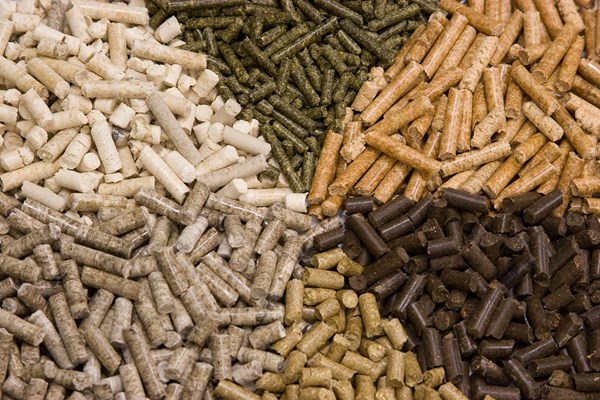Pellets
Definition and properties
A wood pellet with or without additives is a compressed feedstock material, normally cylindrical with broken ends, with a length of typically 5mm to 40mm and a diameter of maximum 25mm. The moisture content of wood pellets normally is less than 10% and they have an ash content of up to 3%. The pellets usually were produced with a pellet mill.
The advantages of pellets compared to log wood or wood chips are among others: the possibility to optimize the combustion because of the uniform fuel, the reduced costs for transportation because of the increased fuel bulk density and the improvement of thermal and combustion properties.

European Standards
The European standard (ISO 17225-2:2014 "Solid biofuels – Fuel specifications and classes – Part 2: Graded wood pellets") defines the quality standards of pellets. There are three different classifications for pellets: A1, A2 and B. The differences are regarding to the used raw materials and their quality. The relevant wood pellet class for end users is A1. A2 and B are used in industrial applications like power plants.
There is also a European standard for pellet stoves (DIN EN 14785:2007-10 “Residential space heating appliances fired by wood pellets – Requirements and test methods”), which defines the requirements. Important requirements are the limits for efficiency and CO emissions for nominal heat output and partial output (if a change of the heat output is possible). At maximum load the efficiency has to be at least 75% and at partial load the efficiency must not be less than 70%. Regarding CO emissions, the defined limit is 500[mg/m³] at nominal heat output and at partial heat output it is 750[mg/m³]. These CO limits are based on 13% oxygen content in the flue gas.
Application in pellet stoves/boilers
Pellet stoves are free-standing devices with or without a viewing window, which are using pellets as fuel. A pellet boiler also provides hot water.
The conditions while burning pellets are much more constant than while burning logwood, because of the homogeneity of the pellets. Therefore pellet-fired units operate more efficiently and have reduced emission rates, as compared to logwood or wood chip units. Another big advantage of pellet stoves/boilers is the possibility of automated fuel feeding. Integrated storage hoppers for pellets even enable automatic operation for several days. The pellets are, for example, transported by a fuel screw into the combustion chamber and usually ignite automatically with a glow plug. Therefore pellet-fired units need electricity during the operation.
Pellet stoves and boilers can be equipped with smart technology, like flue gas sensors, to improve their performance. Pellet-fired units currently are the state-of-the-art solution for biomass combustion.
Production process
Pellets are produced by compaction of e.g. saw dust. For detailed information see pre-treatment technologies.
Raw Materials
The common pellets are made from woody biomass, like sawdust, wood chips or forest residues, but there are a variety of raw materials which can be pelletized. Some examples are paper products, waste biomass, corn, cotton seed, hemp, miscanthus, reed canary grass, straw, cereal spillage, low grade hay etc.. The fuel properties of pellets made from alternative raw materials differ from pellets made from woody biomass. For example: The water content of wood pellets amounts to maximum 15%, otherwise they will fall apart. In contrast, the water content of alternative pellets varies between 7% (corn cobs) and 56% (hemp). Certain fuel properties can be set by mixing different raw materials together in suitable amounts.
